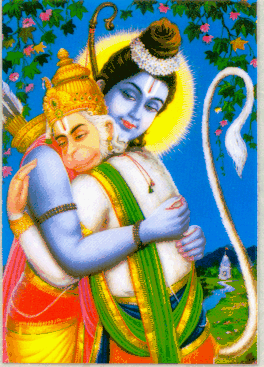

[May
the Lord of the Kosala
country (Sri Rama), protect
us; He who spurned the
emperorship for the sake of
his father ; Who roamed
about from one forest to
another on feet which rivalled
with the softness of the petals
of the lotus and which
could hardly stand even
the touch of his beloved
(Sita) ; Whose langour on
his sojourn was mitigated
by the chief of the
apes (Sugriva) and by his
brother (Lakshmana) ; Who
made the ocean waters tumultous
when his eye-brows knitted in
fierce fury at the separation
from his beloved consequent
to the disfigurement of Surpanakha
; Who built a bridge
across the seas and Who
proved to be the devastating
conflagration of the forest
comprising the wicked.]
The
Ramayana is perhaps the world's
first ever epic poem. It
was composed by India's
greatest bard, the Sage
Valmiki. It is known today
in three different recensions
referred to as the Bombay,
the Bengal and the South
Indian recensions. It is
believed that originally the
text contained 24000 verses- a
thousand each for each letter
of the supreme and sacred
Gayatri chant of 24
syllables. Today, we have -
in all the different versions
or recensions put together
- a collection of well-over
40,000 verses. This perhaps
accounts for certain contextual
and ideological inaccuracies carried
by the texts. As available
now, the whole epic is
divided into seven books
(Kandas) - Bala, Ayodhya, Aranya,
Kiskindha, Sundara, Yudha and
Uttara - split into 647
cantos (Sarga-s). There are opposing
theories of scholars that
"Uttara" does not form
part of the epic and
in the main, the work emanated
from the Sage. The orthodox
view, however, is that
the poem has seven books,
reflected in the descriptive
term Sapta Kanda. It is
still a debated matter
as to when actually this
classic was composed as
little is known about the
composer - a characteristic
feature of ancient Indians
who did not leave behind
any personal details about them,
however great they were
or whatever mighty they had
achieved. They believed that it
was not man but knowledge
that was important. But,
it is obvious that this
monumental effort should have preceded
the magnum opus, the
Mahabharata of the Sage
Vyasa, which is said to
belong to the 5th century
B.C. Suffice to say, the
Ramayana is described as the
first work (Adi Kavya) and
its author as the path-finder
(Margadarsi Maharshi). Indian culture
has its fountain-head in
the hoary Vedic lore which
were the scriptures revealed to
the ancient seers in the
course of their transcendental experiences. Verily
does the Ramayana have the character of the Vedas, as
it weaves a story around a personification
of that Ultimate Reality
sought by the Vedas.
This is seen
in the invocatory verse :
"
vEd vEïE
prE
p¤||¢s
jatE
dSrTaÏmjE ,
vEd:
p#acEtsadas£t¯
saXad#amayNaÏmna .
"
The
word "Ramayana" not only
indicates the title of the
work but means also the
path taken or followed by
Sri Rama, the hero (ramasya
ayanam). This path was the
path of righteousness in all
activities and hence, this
text has come to be
regarded as a code and
manual of correct living, and
hence hailed as a Dharmasastra.
Whosoever
supplicated to the Lord
in unflinching and true devotion,
earned His grace and the
highest human end (Purusartha)
i.e. liberation from transmigratory
existence. It is also
for this reason, glorified as
a doctrinal text on surrender
to the Lord (Saranagati
or Prapatti Sastra). For
the devout, each character
in the epic is a
role-model. What devotion bestows
on one here and in the
hereafter are exemplified in
the episodes interlaced in
the narrative.
The
literary value of the classic
is unparalleled. The imagery,
descriptive beauty, use of apposite
words and expressions to
suit the moods and emotions
and above all, the inimitable
style have inspired all later
writers in literature. This
is readily seen in works
of writers from Kalidasa
to those of the present
day. Thoughts on polity,
economics, administration, war-fare,
battle-rules, duties, ethics and other
aspects needed for leading
a right type of life
lie embedded in it.
It would
be appropriate to recall
the glittering words of
the late Sir C.P.Ramaswamy
Ayyar, about this great classic.
He said that the gift
of poetry came unbidden and
unforeseen to Valmiki, at the
sight of a fowler killing
one of the mating birds
and the Sage expressed himself
in a language which originated
the metrical compositions (sloka
metre ) and which was
acclaimed by the Lord of
Creation (Brahma ) as the
best specimen of classical
poetry :
laEk ev
Ïvya
bÑGaE naæO
kayaI
¢vcarNa ,
mÅCÓdadEv
tE
b#'n¯ p#v¦äOEy|
srÞvt£
.
That
Valmiki's inspiration for composing
the Ramayana arose out
of thoughtless cruelty (on the
part of the fowler), undeserved
suffering (on the part
of the bird) and absorbing
compassion (on the part of
Valmiki) are symbolic of
the warp and woof of
human destiny woven into
cosmic tapestry for the everlasting
delectation of humanity by
the greatest poet of ancient
India.
In offering these
presentations on the Valmiki Ramayana, we have followed the original text
as compiled by the late P.S.Krishnaswamy
Iyer in the Dharmalaya Edition, and
published by the late Sri. M.N.Ramaswamy Iyer, both of whom were committed
to the preservation and dissemination of the ancient Indian heritage. We
are grateful to Dr.Santha Ramachandran, and Sri.K.Ramkumar, who, on behalf
of members of their families, has permitted us to use their great work.